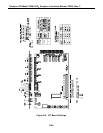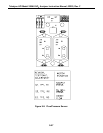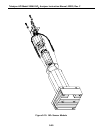
Teledyne API Model 200AU NO
X
Analyzer Instruction Manual, 02293, Rev. F
9-52
9.3.6 Ozone Generator
CAUTION - DANGER
Lethal voltages present inside Ozone Generator Turn
off instrument before servicing. Unplug Generator
before dis-assembling.
The ozone generator subsystem consists of a permeation drier, flowmeter, power supply -
generator module, and power switch. The location of the components is illustrated in Figure 9-7.
Ozone is generated by drying ambient air, passing the air between two electrodes that have a
large oscillating electric field generated by a high voltage transformer.
Common faults in the ozone generator are:
1. A leak or some other failure in the drier will let ambient air into the generator. There is
enough water vapor in room air to cause the generator to make nitric acid aerosol. It is very
corrosive and causes the generator cartridge to short out due to salt build-up. This reduces
the ozone concentration generated which can cause the analyzer to be non-linear due to
insufficient ozone concentration.
2. Contaminated ozone generator cartridge. Salts and oxgenated hydrocarbons can be
removed by rinsing with 10% nitric acid at 50
°
C, followed by de-ionized water rinse, then
dry air purge.
3. Shorts, open circuits, arcing. Because of the very high voltages, the glass ozone generator
cartridge may crack and cause an internal arc or short circuit. Measure the voltage between
TP-4 and TP-5 on the Ozone Generator Driver Board. The voltage should be 0.045
±
.005
VDC, indicating that the drive current is about .45 A. If the value is either zero or
significantly greater than 0.45, the ozone generator is faulty.


















